Winter moth update February 28, 2020
Winter moth update, February 28, 2020
With such a warm winter sending out winter moth information earlier rather than later seems like a good idea. I don’t expect winter moth caterpillars to be a problem in 2020, so you may want to stop reading right now! For those of you still interested in winter moths, read on.
Over the last decade, winter moth eggs have start hatching anywhere from mid-March to mid-April, depending primarily on temperature. I don’t expect eggs to hatch until after red maples start blooming and when McIntosh apple buds crack open and expose a little bit of green tissue. Hopefully this is still many weeks away!
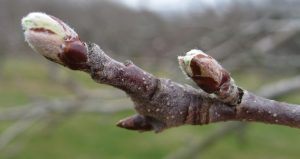
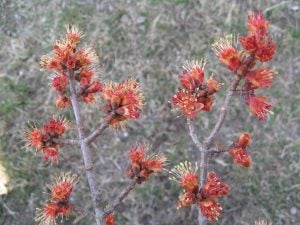
Winter moth eggs tend to hatch at McIntosh apple ‘green tip’ and red maple tree bloom.
Tree wraps were set up in early November, 2019, to monitor eggs at 3 locations in RI: Kingston, Charlestown, and Portsmouth. In November and December, as female winter moths climbed trees and encountered tree wraps, female moths deposited eggs below the wraps, aggregating eggs, and making it easier to monitor egg hatch. Winter moth eggs are orange now, but turn blue a couple of days before hatching. This trait makes it very handy for monitoring egg hatch!
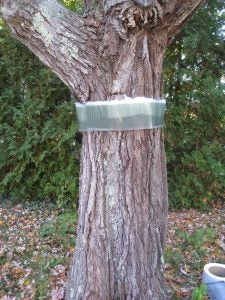
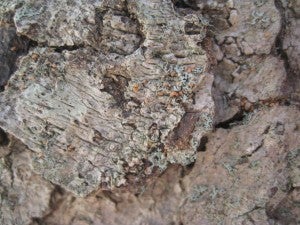
Tree wrap and close up of small, orange winter moth eggs found below tree wrap.
Eggs are nearly impossible to find without setting up tree wrap in the fall.
So far tree wraps have been removed at only one of the three locations. There are plenty of winter moth eggs to monitor, but there seem to be fewer eggs than in 2019. Good news so far!
Overall, it seems that winter moth populations have declined in southeastern New England, and several people commented to me that they did not see many male moths flying in November and December, 2019. The reason for the collapse of the winter moth population is due to natural predator populations building up and the release of a parasitic fly, Cyzenis albican. This fly, which parasitizes only winter moth caterpillars, was released in 8 locations throughout Rhode Island from 2011-2018. This is the same fly that controlled the winter moth problem in Nova Scotia and the Pacific Northwest.
I don’t think landscape trees will need protecting from winter moth caterpillars this year, nor did I think any landscape trees needed protecting in 2018 or 2019. I didn’t see any trees defoliated by winter moth last year. If landscape trees do need protecting, probably the best time to spray will be late April or early May after trees leaf-out, while caterpillars are still small, and before excessive feeding damage has occurred.
I also don’t expect most fruit growers (apple, pear, and blueberry) to need to spray for winter moth caterpillars this year. Last year only a few fruit plantings required spraying with an insecticide. In past years, when we were under outbreak conditions, growers needed to spray at egg hatch to protect flower buds from winter moth caterpillars entering buds in large numbers. Now, since our winter moth population is much lower, we can wait until caterpillars are a few weeks old, and flower buds are more developed, before deciding if an insecticide treatment is needed. The best time to look for caterpillars will be sometime in April or May when apples trees are at the tight cluster bud stage, or bud separation stage (see pictures below). It is much easier to control winter moth caterpillars weeks after eggs hatch rather than try to kill them when they are newly hatched caterpillars and before they enter buds. And if an insecticide application is warranted, probably only one spray will be needed.
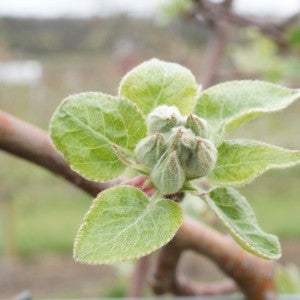
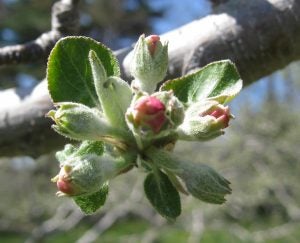
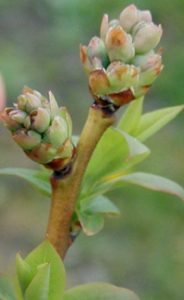 Apple tight cluster and apple bud separation are good times to look for caterpillars. Blueberries are more difficult to check.
Apple tight cluster and apple bud separation are good times to look for caterpillars. Blueberries are more difficult to check.
Winter moth caterpillars are pretty easy to kill once they are a few weeks old and moving from bud to bud. B.t. kurstaki products (Bacillus thuringiensis kurstaki) such as DiPel, Thuricide (for backyard growers), and Biobit work well controlling winter moth caterpillars, and these products kill only caterpillars. Many insecticides also kill winter moth caterpillars, but these kill other insects as well. Spinosad products are very effective, but do not spray spinosad near open flowers because it will kill bees for up to 3 hours after applying. Spinosad products are Delegate and Conserve (for commercial growers), Entrust (for organic, commercial growers), and Captain Jack’s Deadbug Brew (for backyard growers).
Just a word about gypsy moths – there were a few locations in Burrillville with high numbers of gypsy moths in 2019, but wet weather in June allowed the fungal pathogen, Entomophaga maimaiga, to kill most caterpillars! You’ve got to love some fungal pathogens.
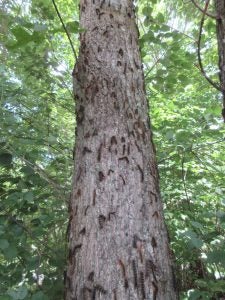
Gypsy moth caterpillars dead due to Entomophaga maimaiga.
June 26, 2019
Heather Faubert
URI Cooperative Extension
 Home
Home Browse
Browse Close
Close Events
Events Maps
Maps Email
Email Brightspace
Brightspace eCampus
eCampus


